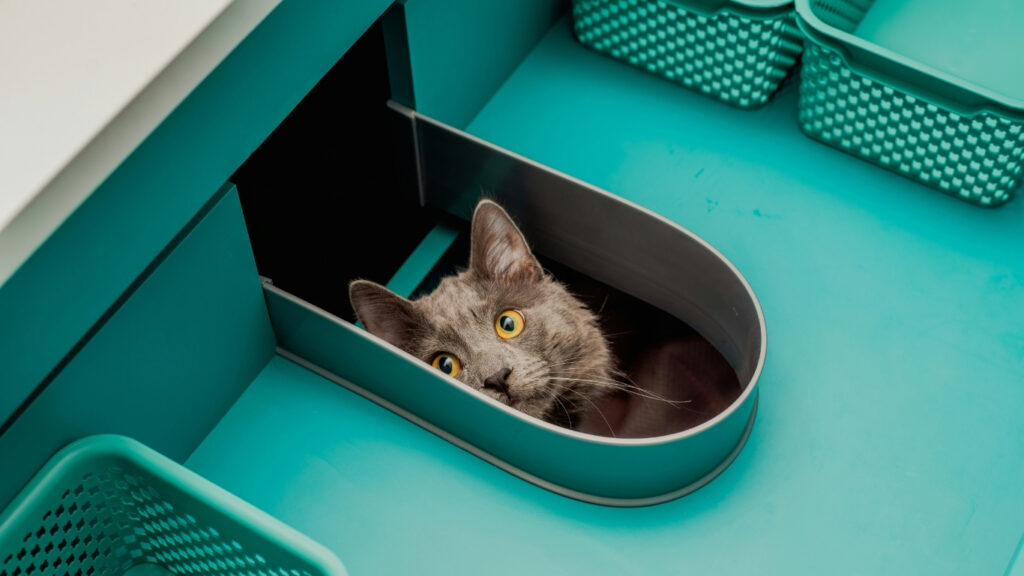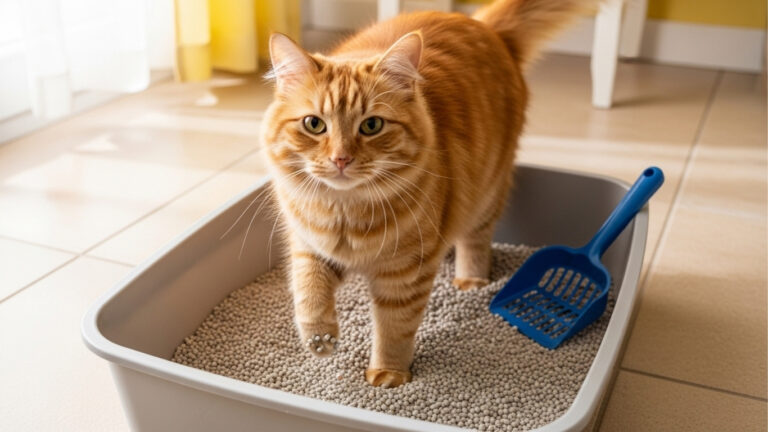You just set up a new litter box sleek, spacious, and an upgrade. Naturally, you assume your cat will waltz over, give it a test dig, and handle their royal business. But nope. Instead, they sniff it suspiciously, glare at you like you’ve committed a personal offense, and strut off as if you tried to swap their throne for a cardboard box.

If you’re wondering how to attract cat to new litter box without turning your home into a litter battleground, take a breath. This is super common! Cats hate change. They’re picky and stubborn and have their quirky bathroom preferences. Don’t stress there’s a way forward. Give it some time and use a few thoughtful tactics, and soon, your cat will be loving their new litter box like it’s been their favorite spot all along.
Contents
- 1 Why Do Cats Get So Fussy About Litter Boxes?
- 2 Step 1: Pick the Right Box Size and Style Are Important
- 3 Step 2: Location – The Secret Spot
- 4 Step 3: Cleanliness Is Key
- 5 Step 4: Make the Switch Slowly – Don’t Rush It
- 6 Step 5: Try Some Catnip or Attractants
- 7 Step 6: Help Your Cat Relax and Feel Safe
- 8 Step 7: Eco-Friendly Litters Are Becoming Popular
- 9 Step 8: When to Worry and Call the Vet
- 10 FAQs About How to Attract Cat to New Litter Box
- 11 Final Thoughts: Patience, Understanding, and a Dash of TLC
- 12 About the Author
Why Do Cats Get So Fussy About Litter Boxes?
Cats are creatures of habit. They like routines and familiar smells. Their sense of smell is stronger than ours, so a new box with unfamiliar scents can feel scary or strange. Plus, they have definite ideas about how their litter should feel under their paws and where their bathroom should be.
A sudden change whether it’s the box itself, the litter, or even where you put it can throw them off. So, understanding their perspective is key when you want to figure out how to successfully attract cats to a new litter box.
Step 1: Pick the Right Box Size and Style Are Important
Imagine using a tiny bathroom stall that barely fits you that’s how your cat might feel if the box is too small. Your kitty needs enough room to turn, dig, and squat comfortably.
Also, style counts. Covered boxes give privacy, but some cats hate feeling trapped inside. Open boxes are more inviting for some, but litter might scatter more.
Pro tip: If your cat is used to an open box, don’t immediately shock them with a covered one. Try to keep the style familiar during the switch.
Step 2: Location – The Secret Spot
Cats want privacy but also need to feel safe when using their box. Don’t put the new litter box near noisy appliances or heavy foot traffic.
Start by placing the new box near the old one so your cat doesn’t have to search for it. Then, slowly move it to the spot you want over several days or weeks.
Read More: How Much Cat Litter to Use: Expert Tips for Every Cat Household
Step 3: Cleanliness Is Key
Cats are fastidious. They avoid dirty boxes. Scoop waste every day and change litter regularly.
Avoid scented litter. Although it smells nice, it can overwhelm your cat’s sensitive nose. For the best results, use unscented, low-dust litter.
Step 4: Make the Switch Slowly – Don’t Rush It
A gradual transition is the easiest way to attract your cat to a new litter box. Put the new box next to the old one, and mix a little of the old litter into the new one.
Let your cat explore both boxes freely. Over one or two weeks, increase the amount of new litter while decreasing the old.
Step 5: Try Some Catnip or Attractants
A sprinkle of catnip near or inside the new box can make your cat curious enough to check it out. If catnip isn’t your cat’s thing, you can try pheromone sprays made to encourage litter box use. These sprays calm your cat and make the new box feel safe.
Step 6: Help Your Cat Relax and Feel Safe
Some cats get anxious when they see change. Play with your cat more, give treats near the new box, and consider using calming pheromone diffusers.
Set up a comfy little nook near the new litter box something soft, quiet, and private. This will give your cat a sense of security while they scope out their mysterious new bathroom upgrade.
Step 7: Eco-Friendly Litters Are Becoming Popular
More cat owners are switching to natural litter made from corn, pine, or recycled paper. These options are often softer on paws and better for the environment.
If you’re trying a new type of litter, mix it gradually with the old one to avoid a sudden change in texture or smell.
Step 8: When to Worry and Call the Vet
A vet check is good if your cat refuses the new box after weeks or starts peeing outside. When your cat is dealing with issues like arthritis or a urinary tract infection, even a simple trip to the litter box can be uncomfortable. So they might start avoiding it altogether.
Taking care of health problems helps your cat feel better and return to good habits.
Read More: How Much Cat Litter to Put in Box: Expert Tips
FAQs About How to Attract Cat to New Litter Box
Q1: How long does it usually take a cat to get used to a new litter box?
Most cats adjust within one to two weeks, especially with a slow transition.
Q2: Is scented litter okay?
Better to avoid it. Cats’ noses are sensitive, and strong scents can be off-putting.
Q3: How many litter boxes do I need for multiple cats?
Give each cat their box, and add one more for good measure.
Q4: What if my cat pees outside the box?
Clean the spot thoroughly with an enzyme cleaner and see a vet if it continues.
Q5: Do self-cleaning litter boxes help?
Some cats love them, others find them scary. It depends on your cat’s personality.
Final Thoughts: Patience, Understanding, and a Dash of TLC
Switching to a new litter box can be a big deal for your cat they’re not tricky, just figuring out what feels right.
With the perfect box, a cozy spot, a fresh and tidy space, and a slow, steady introduction, your furry friend will soon love their new setup. Stick with it you’re on the right track!







